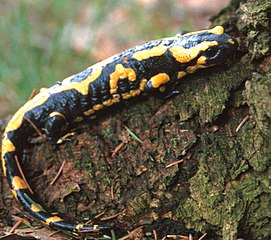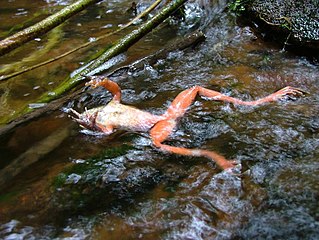As a herpetologist and animal keeper, I’ve long been interested in the emerging amphibian disease commonly known as Chytrid or BD (Batrachochytrium dendrobatitis); please see my other articles, linked below. Believed to be responsible for the recent extinctions of over 200 frog species, this fungus remains a serious threat. In 2013, a related fungus, B. salamandrivorans, or BS, was identified. Since then, studies have revealed it to be as lethal as BD, and responsible for wiping-out the Netherlands wild Fire Salamanders. Once limited to Asian salamanders, some of which carry the fungus without becoming ill, BS seems to have found its way to Europe via the importation of Chinese Fire-Bellied Newts and other pet trade species. In order to stem the tide, the USA and the European Union are now considering import and sale regulations.
Proposed regulations always raise hackles among pet-keepers and some politicians. However, amphibians sold in the pet trade (African Clawed Frogs), bait trade (Tiger Salamander larvae) and food trade (American and Asian Bullfrogs) have been implicated in the spread of the deadly Chytrid (BD) fungus, and released Burmese Pythons and various exotic fish are causing ecological havoc in Florida. So – what is the solution? Your thoughts would be most appreciated, please post below.
100% Mortality in North American Newts
As reported in Science Magazine (V. 346, No. 6209, Oct., 2014), researchers tested 5,000 salamanders from 4 continents for susceptibility to the newly-discovered fungus. Of the 35 species examined, some showed 100% mortality. Included in this group were 2 well-known US natives, the Eastern Newt and the Rough-Skinned Newt.
Several Asian salamanders were unaffected by BS, spurring fears that such individuals, while appearing to be healthy, could serve as long-term carriers capable of transmitting the fungus to other species.
Pet Trade Connection
The millions of Chinese Fire-Bellied Newts imported into Europe from Asia are believed to be the primary route by which BS was spread to the Netherlands’ now extinct Fire Salamanders. The fungus may have found its way into natural habitats via discarded terrarium water and/or released pets. According to researchers at the Imperial College of London, there is no way to limit the spread of the fungi populations that are already established in Europe, and herpetologists predict that more local extinctions will be documented. The EU is considering restrictions on amphibian imports under various animal health laws.
Fire-Bellied Newts and other Asian species are also popularly kept in the USA, home to the world’s greatest diversity of salamander species. With so many US natives already decimated by BD and habitat loss, and scores naturally limited to tiny ranges (i.e. the Texas Blind Cave Salamander), the arrival of BS would be disastrous.
Congress, US F&W Service Taking Action
According to a recent New York Times op-ed piece (Oct. 31, 2014), Congress is considering increasing the US Fish & Wildlife Service’s authority to regulate the importation of pet trade animals. However, the process is being resisted by anti-regulation members.
Working in conjunction with the US F&W Service, the Pet Industry Joint Council is seeking ways to limit the threat posed by imported Asian salamanders.
Hi, my name is Frank Indiviglio. I’m a herpetologist, zoologist, and book author, recently retired from a career spent at several zoos, aquariums, and museums, including over 20 years with the Bronx Zoo.
Please check out my posts on Twitter and Facebook. Each day, I highlight breaking research, conservation news and interesting stories concerning just about every type of animal imaginable. I look forward to hearing about your interests and experiences as well, and will use them in articles when possible.
Please also post your questions and comments below…I’ll be sure to respond quickly. Thanks, until next time, Frank.
Further Reading
 That Reptile Blog – Reptile, Amphibian and Exotic Pet Care and Information
That Reptile Blog – Reptile, Amphibian and Exotic Pet Care and Information








Sad to think that salamander keepers could be unintentionally endangering local salamanders. Rather than banning imported salamanders though, I would much rather see research done on methods to kill the fungus before discarding used terrarium water and advisories/regulations based upon preventing the spread of the fungus.
Hi Rachel,
Thanks…unfortunately the related fungus that infects frogs has proven impossible to control despite decades of research…some promising natural immunities (see articles at Further Reading), but no answer. Import bans would be necessary if the fungus is found in animals to be shipped to the USA. Best, Frank